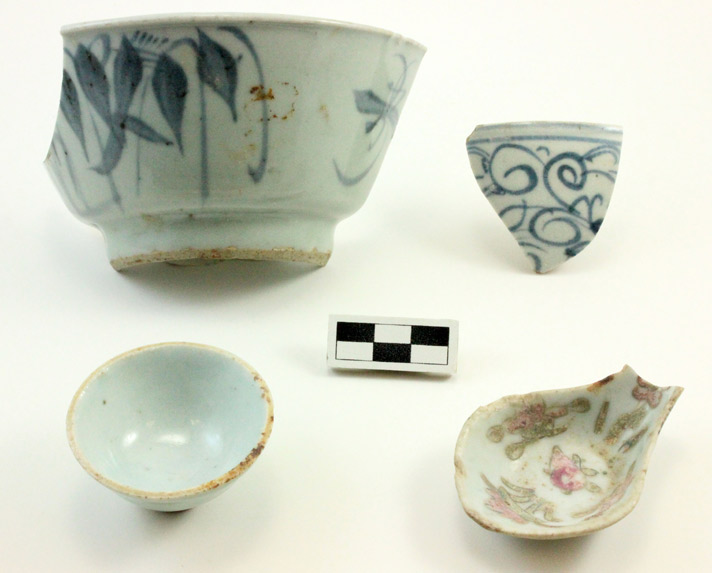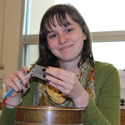Digging Jacksonville – May 2015
Imported ceramics are one of the most common artifact types found in Chinese sites in the American West, and Jacksonville’s Chinese Quarter site is no exception. A large collection of ceramic tableware and storage vessels were found at the burned Chinese house excavated by the Southern Oregon University Laboratory of Anthropology (SOULA) in 2013. This article will focus on a collection of dishes found at the site, which represent the four most common types of imported Chinese porcelain being produced during the 1800s. These mass-produced, utilitarian ceramics would have been affordable for Chinese laborers on the West Coast.
The imported utilitarian porcelain can be divided into four distinctive types, which make them easy to identify even from small fragments. Decorative styles changed over time, allowing archaeologists to establish an approximate age for each design. The earliest imported ceramic design is the Double Happiness pattern, followed by the Bamboo, Four Flowers, and Winter Green designs. Archaeologist and historians continue to research how these ceramics were made and the importance of their decorative styles.
The earliest imported ceramics contain the Double Happiness pattern. This pattern, named for the presence of the Chinese character for ‘double happiness,’ is done in blue paint on white ceramic. This design is only used to decorate bowls. Each dish is hand painted, and in cases of mass production, the distinctive Chinese character loses its shape and often appears as a series of stylistic swirls.
Another ceramic design used only on bowls is the Bamboo Design. These porcelain wares are blue-grey in color and feature images of bamboo paired with a rock and blossom. Other patterns in this design have been interpreted as either a dragonfly or a mushroom. This pattern stopped being imported in the United States during the 20th century.
A third design, known as the Four Flowers or Four Seasons pattern, is found not only on bowls, but on a variety of dishes, spoons, and cups. This design features four flowers, each representing a different season: the peony (spring), lotus (summer), chrysanthemum (fall), and plum (winter). This design is more modern than the Double Happiness and Bamboo patterns, and can still be found today.
The final group of ceramics, known as Winter Green, is characterized by an ash glaze which gives it a distinctive color. This design, commonly known today as celadon, appears on various types of tableware and can be found both plain and decorated. Celadon is still being produced today, but traditional celadon ceramics are referred to in merchant records as Winter Green ceramics.
The types of ceramics found in overseas Chinese sites tell archaeologists about the daily lives of Chinese laborers. Unlike their Euro-American neighbors, who utilized a wide variety of dishes on a daily basis, a Chinese meal was often consumed with a traditional place setting which most often included a bowl, spoon, chopsticks, and small cup. These artifacts are always found associated with Chinese sites, suggesting that these items were an important and familiar part of daily life. While Euro-American ceramics could have been purchased easily, and cheaply, a preference for traditional vessel forms and decorative styles can be seen in the archaeological record. This demonstrates the importance of maintaining traditional lifeways for overseas Chinese workers.
The excavations in the Jacksonville Chinese Quarter were funded by the City of Jacksonville and the Oregon Department of Transportation.

 Emily Helmer is a sophomore at Southern Oregon University, and is currently working in the SOULA lab with the Jacksonville Chinese Quarter site assemblage. You can reach SOULA by contacting Chelsea Rose at rosec@sou.edu and follow SOULA on
Emily Helmer is a sophomore at Southern Oregon University, and is currently working in the SOULA lab with the Jacksonville Chinese Quarter site assemblage. You can reach SOULA by contacting Chelsea Rose at rosec@sou.edu and follow SOULA on